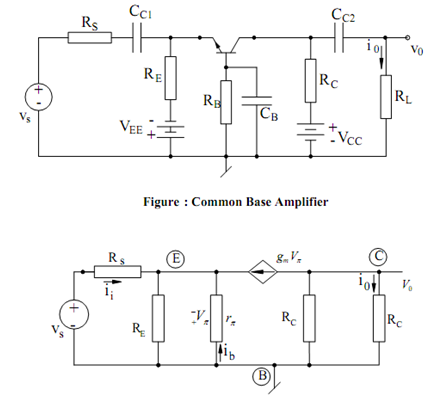Common-base Amplifier:
An exemplary common-base amplifier is illustrated in Figure and its small ac equivalent is illustrated in Figure. A routine analysis of the equivalent circuit gives :
V0 =- ( gm Vπ ) (Rc || RL )
Application of KCL at the emitter node gives :
g m V π + (Vπ / rπ )+ (Vπ / RE )+ Vs - (- Vπ ) /RS = 0
since β = gm rπ, we can write :
V π ((1 +β / r π )+ (1/RE )+ (1/RS)) = -Vs/Rs
from where we get
Vπ =- Vs / Rs [(rπ /1 +β )|| RE || Rs ]

Figure: Small Signal Equivalent Circuit of Common Base Amplifier
The small signal voltage gain of the circuit is, thus, found to be
Av = V0 /VS = + gm ((Rc || RL )/ Rs) [(rπ/1+β || RE || Rs )
as Rs → 0, Av ≅ gm (Rc || RL )
The current gain Ai =I0/Ii may be determined as follows. The KCL equation at the emitter is given by
I i + (Vπ /r π )+ g m v π + Vπ /RE=0
from which we obtain
V π = - Ii = ( rπ / ( 1+β) || RE]
The load current is given by
I0 =- ( gm Vπ ) (RC / RC + RL )
Hence, I0 /Ii is found to be
Ai = I0 / Ii = gm (Rc / Rc + RL) [[ rπ /1 + β) || RE ]
In the limiting case, as RE → ∞ and RL → 0, then current gain becomes the short circuit current gain specified by
A i0 = gm rπ / 1 +β = β/1 +β = α (as expected)